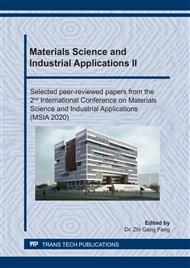p.28
p.35
p.41
p.47
p.53
p.61
p.67
p.73
p.79
Magnetic Properties and Crystal Structure of (Fe,Ni)2( P,Si) Quaternaries of Fe2P-Type
Abstract:
(Fe,Ni)2(P,Si) compounds were synthesized and characterized. Ni substitution in Fe1.95-xNixP0.7Si0.3 is found to favor the formation of Fe2P-type hexagonal structure. The samples appear nearly single phase. Powder oriented in the magnetic field shows a pronounced uniaxial magnetic anisotropy with c axis as the easy axis. Magnetization measurements carried out along and perpendicular to the c crystal axis demonstrate a significant magnetic anisotropy, making these materials potential candidates for permanent magnet applications. We found that (Fe,Ni)2(P,Si) compound has no remanent magnetic field and coercivity, but it has a large magnetocrystalline anisotropy at room temperature. Therefore, doping Fe2P type compounds with a small amount of Ni and Si may be a promising way to create new materials with large magnetocrystalline anisotropy at room temperature, and thus rare-earth free permanent magnet.
Info:
Periodical:
Pages:
53-60
Citation:
Online since:
July 2020
Authors:
Price:
Сopyright:
© 2020 Trans Tech Publications Ltd. All Rights Reserved
Share:
Citation:


